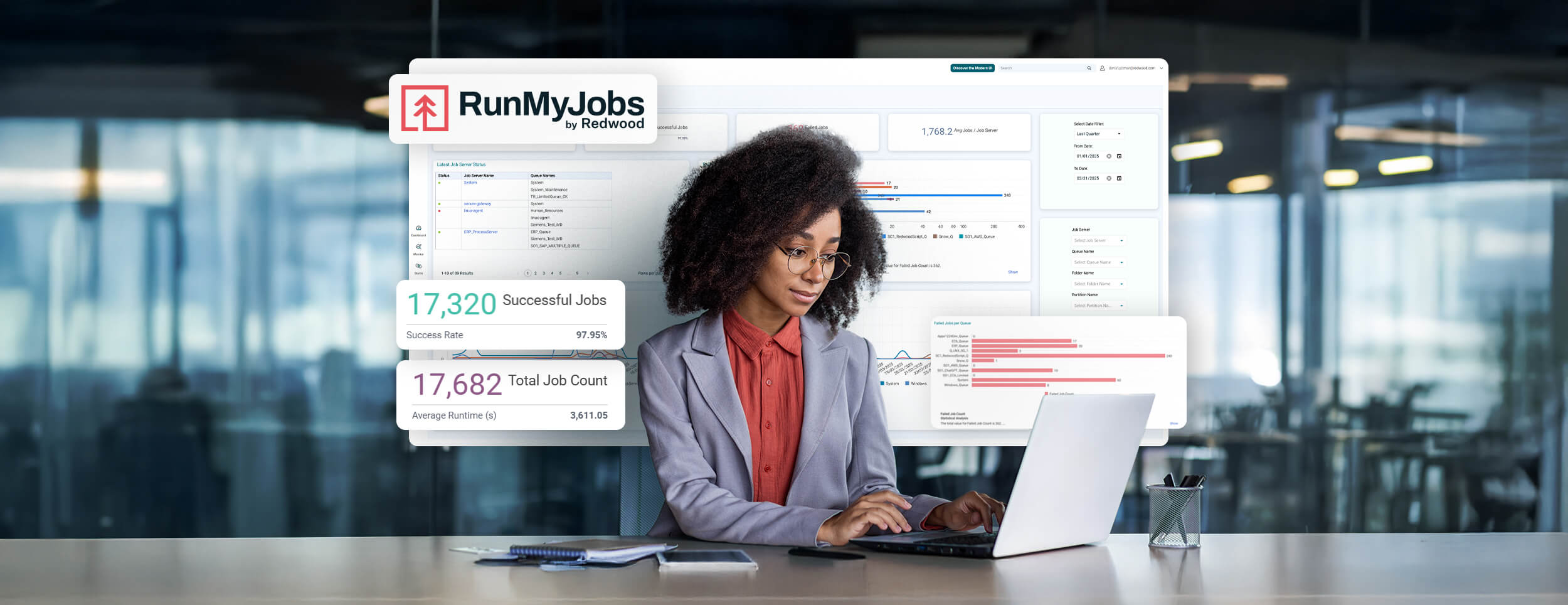The observable enterprise: Navigating complexity in workload automation

IT environments today are anything but simple. Distributed systems, cloud-native applications and always-on operations have turned traditional monitoring approaches into a game of catch-up. And visibility gaps are no longer tolerable, especially when a single failure in a job chain can ripple across your business.
This is why observability is key. A concept originating from IT monitoring and AIOps, observability goes beyond simply monitoring what you think is important. It’s about being able to ask any question about your systems and understand their internal states based on the data they produce: logs, metrics and traces.
Applying observability principles to workload automation and Service Orchestration and Automation Platforms (SOAPs) can help you handle complexity and orchestrate peak performance in your mission-critical automation fabrics.
Automation is leveling up
Several key trends are driving the need for sophisticated automation. Industry 4.0 adoption, the relentless pursuit of supply chain resilience and the demand for real-time business intelligence all require a new level of powerful and transparent automation.
This requires a new kind of automation. SOAP solutions play a critical role, enabling real-time coordination of smart devices and systems. They provide centralized control, from production schedules and quality checks to predictive maintenance. Automation platforms are empowering organizations to guarantee the reliability of intricate IT and business services at scale.
What observability really means
Observability is built on three core principles:
- Telemetry: Gathering rich data from your systems. This means collecting logs, metrics and traces to capture every facet of their behavior.
- Context: Adding meaningful information to this data. Understanding the relationships and dependencies between different components is crucial.
- Exploration: Empowering you to ask any question and investigate system behavior, even questions you didn’t anticipate.
Unlike traditional monitoring, which focuses on predefined metrics and alerts, observability allows you to proactively investigate issues, identify root causes faster, improve system performance and enhance agility. It’s about moving from reactive firefighting to proactive optimization.
As the automation industry changes to adapt to new business models and an increase in technical and data complexity that shows no signs of slowing down, focusing on observability as a key concept in the automation space is critical.
Applying observability to workload automation and SOAP
Observability brings significant value to workload automation and SOAPs, turning abstract job chains into fully transparent systems. It gives operators and administrators the tools they need to answer key questions like: Which jobs are running late? Where is the bottleneck? What impact will a failed step have downstream?
Here’s how that looks in practice:
- Integration monitoring: Tracking the health and performance of integrations with other systems and applications, such as ERPs, CRMs and cloud services
- Job-level insights: Monitoring individual jobs or tasks within workflows, analyzing resource utilization, tracking error messages and measuring performance metrics
- Predictive analysis: Leveraging observability data to predict potential issues and optimize automation performance before disruptions occur
- Workflow visibility: Gaining deep insights into the execution of your automated workflows and understanding dependencies, tracking execution times and pinpointing success/failure rates
To effectively leverage observability, your workload automation or SOAP solution needs specific capabilities:
- Alerting and automation: Enable proactive alerting based on observability data and trigger automated actions to address issues.
- Contextualization: Enrich data with context using tags, metadata and workflow IDs for meaningful analysis.
- Data collection: Robustly collect detailed telemetry data (logs, metrics, traces) from all components of the automation platform and its integrations.
- Visualization and analysis: Provide powerful tools for visualizing observability data, creating dashboards and performing root cause analysis.
Consider these real-world examples.
Supply chain optimization
By applying observability principles, organizations can gain end-to-end visibility into their complex supply chain workflows, tracking the execution of various automated procurement, manufacturing and logistics tasks. This deep insight allows them to pinpoint exactly where bottlenecks are occurring, such as delays in raw material processing or inefficiencies in distribution, ultimately unlocking hidden efficiency and ensuring greater supply chain resilience against disruptions.
Business process assurance
Observability provides the granular detail necessary for troubleshooting failures in critical business processes like order processing or financial transactions, going beyond simple error notifications to reveal the precise step and underlying cause of the issue within the automated workflow. By monitoring individual jobs and integrations involved in these processes, organizations can quickly identify whether a problem stems from a failing application connection, a data validation error or a resource constraint. Thus, it enables faster resolution and minimizes costly disruptions to essential business operations.
Resource efficiency
Through observability, organizations can monitor the resource utilization of individual automated tasks and workflows, gaining a clear understanding of CPU usage, memory consumption and I/O operations. This detail allows them to identify underutilized resources that can be reallocated or optimize the scheduling of resource-intensive jobs to avoid contention. The outcomes of wisely navigating complexity instead of letting it overtake operations? Improved overall efficiency and reduced operational costs.
Properly implemented, observability allows you to predict disruptions instead of reacting to them.
Knowing what’s about to happen: AI in observability and automation
With observability in place, automation becomes more than a set-it-and-forget-it system. AI is allowing businesses to use automation to highlight weak points, adapt to changes and continuously improve. Its integration with observability and automation platforms unlocks new levels of efficiency and intelligence.
AI enhances observability with smart narratives for data views that enable deeper data exploration and deliver real-time operational insights. This empowers teams to orchestrate workflows in perfect harmony and predict bottlenecks before they happen.
AI-driven automation is also moving beyond simple task execution to more complex, autonomous operations. The near future will include AI that operates autonomously to optimize performance and resolve issues, collaborates with users to automate complex tasks and provides instant information and guidance.
By integrating AI, automation platforms are evolving to provide a seamless experience, taking users from data to insights to action in a single step.
Redwood Insights: Observability built for orchestration
The need for enhanced visibility and control is transforming how enterprises approach automation. It’s no longer enough to simply automate; applying observability principles to orchestrate critical business processes is essential for achieving operational excellence.
To address this, Redwood Software is introducing a new solution that empowers users to visualize every process in motion, predict bottlenecks and turn uncertainty into opportunity. Today, Redwood announced Redwood Insights, a platform-level add-on that’s first being integrated into RunMyJobs by Redwood, a market-leading automation solution.
Redwood Insights will deliver:
- Role-based dashboards for operators and administrators
- Orchestration analytics that provide actionable intelligence
- AI features with smart narratives for data views and deeper data exploration
- Analytics and visualizations to identify problems and bottlenecks before they impact operations
Redwood Insights, integrated with RunMyJobs, enables users to visualize every process in motion, predict bottlenecks and turn uncertainty into opportunity.
Applying observability to workload automation and SOAP offers a path from chaos to clarity. It empowers organizations to achieve autonomous transformation, optimize operations and thrive in a complex digital world.
With the launch of Redwood Insights, Redwood aims to transform automation from an opaque process into a transparent, self-healing ecosystem. By embracing observability and AI-driven insights, you can move from simply managing automation to truly orchestrating business harmony.
Learn more about how Redwood’s automation solutions and Redwood Insights can help you harness the power of observability and AI to achieve precision, synchronization and harmony in your business operations.
About The Author

Dan Pitman
Dan Pitman is a Senior Product Marketing Manager for RunMyJobs by Redwood. His 25-year technology career has spanned roles in development, service delivery, enterprise architecture and data center and cloud management. Today, Dan focuses his expertise and experience on enabling Redwood’s teams and customers to understand how organizations can get the most from their technology investments.